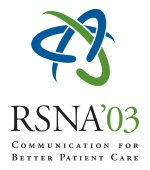
Abstract Archives of the RSNA, 2003
M14-1147
The Death of the Babygram: Radiographic Skeletal Survey Practices in Suspected Infant Abuse
Scientific Papers
Presented on December 3, 2003
Presented as part of M14: Pediatric (Pediatric Musculoskeletal)
Patricia Kleinman MPH, RT(R), PRESENTER: Nothing to Disclose
Abstract:
HTML
Purpose: Infant abuse is responsible for significant morbidity and mortality, and in recent years, efforts have been directed toward the implementation of a thoroughly and meticulously performed skeletal survey, rather than the babygram, a study encompassing the infant skeleton in one or two exposures. The purpose of this study was to determine current national radiographic skeletal survey practices in suspected infant abuse.
Methods and Materials: Of 176 members of the National Association of Children's Hospitals and Related Institutions (NACHRI), 156 (88.6%), performed radiographic skeletal surveys for suspected infant (< 1 year old) abuse and were eligible to participate in this study. Successful contacts were made with radiology staff from 138 (88.5%) facilities who agreed to participate and questionnaires were mailed. The survey included questions regarding the type of facility, imaging department volume, radiographic equipment (film/screen versus digital) and details of skeletal survey imaging practices.
Results: 98 completed questionnaires were returned (completion rate: 71.0%) from 51 freestanding children's hospitals (52.0%), 45 children's hospitals within a hospital (45.9%), and 2 community hospitals (2.0%). 79.6% of facilities reported > 10 images and 31.8% specified > 15 images in their skeletal survey protocol. Only 1% of facilities performed <3 images. 44.9% of facilities used film/screen imaging and 55.1% used digital, (CR=92.6%; DR=7.4%). Of digital users, 72.2% interpreted from a monitor and 27.8% from printed images. Of film/screen users, 53.3% used a high detail imaging system, while only 20.4% of digital users employed a high resolution technique (p=.002). Upper extremities were imaged separately with at least two exposures in 70.5% of film/screen users compared to 83.3% of digital users. Lower extremities were imaged separately with at least two exposures in 72.8% of film/screen users compared to 81.5% of digital users. 97.7% of film/screen users performed lateral images of the spine compared to 98.1% of digital users. Of film/screen users, 50% have already migrated or plan to migrate to digital technology within 1 year.
Conclusion: Skeletal survey imaging practices vary substantially among pediatric facilities, but the majority report performing relatively thorough examinations, rather than babygrams. With migration from film/screen to digital technology, care should be taken to maintain the image quality currently achievable by film/screen systems to optimize detection of inflicted skeletal injury.
Questions about this event email: patbelanger@comcast.net
Kleinman MPH, RT(R), P,
The Death of the Babygram: Radiographic Skeletal Survey Practices in Suspected Infant Abuse. Radiological Society of North America 2003 Scientific Assembly and Annual Meeting, November 30 - December 5, 2003 ,Chicago IL.
http://archive.rsna.org/2003/3108613.html

